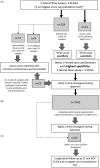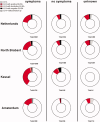Two-tiered SARS-CoV-2 seroconversion screening in the Netherlands and stability of nucleocapsid, spike protein domain 1 and neutralizing antibodies
- PMID: 33684020
- PMCID: PMC7967720
- DOI: 10.1080/23744235.2021.1893378
Two-tiered SARS-CoV-2 seroconversion screening in the Netherlands and stability of nucleocapsid, spike protein domain 1 and neutralizing antibodies
Abstract
Background: Serological testing in the COVID-19 pandemic is mainly implemented to gain sero-epidemiological data, but can also retrospectively inform about suspected SARS-CoV-2 infection.
Method: We verified and applied a two-tiered testing strategy combining a SARS-CoV-2 receptor-binding domain (RBD)-specific lateral flow assay (LFA) with a nucleocapsid protein (NCP) IgG ELISA to assess seroconversion in n = 7241 individuals. The majority had experienced symptoms consistent with COVID-19, but had no access to RT-PCR testing. Longitudinal follow-up in n = 97 LFA + individuals was performed up to 20 weeks after initial infection using NCP and spike protein S1 domain (S1) IgG ELISAs and a surrogate virus neutralization test (sVNT).
Results: Individuals reporting symptoms from January 2020 onwards showed seroconversion, as did a considerable proportion of asymptomatic individuals. Seroconversion for symptomatic and asymptomatic individuals was higher in an area with a known infection cluster compared to a low incidence area. Overall, 94% of individuals with a positive IgG result by LFA were confirmed by NCP ELISA. The proportion of ELISA-confirmed LFA results declined over time, in line with contracting NCP IgG titres during longitudinal follow-up. Neutralizing antibody activity was considerably more stable than S1 and NCP IgG titres, and both reach a plateau after approximately 100 d. The sVNT proved to be not only highly specific, but also more sensitive than the specificity-focussed two-tiered serology approach.
Conclusions: Our results demonstrate the high specificity of two-tiered serology testing and highlight the sVNT used as a valuable tool to support modelling of SARS-CoV-2 transmission dynamics, complement molecular testing and provide relevant information to individuals.
Keywords: ELISA; SARS-CoV-2; lateral flow assay; longevity; neutralizing antibodies; serology.
Conflict of interest statement
AG is a senior officer and shareholder, and AS, DWAvdN, APFS, ESD, LSvG and MLCEK are employees of Innatoss Laboratories B.V., which provides diagnostic screening for infectious diseases including SARS-CoV-2.
Figures




References
MeSH terms
Substances
LinkOut - more resources
Full Text Sources
Other Literature Sources
Medical
Miscellaneous
